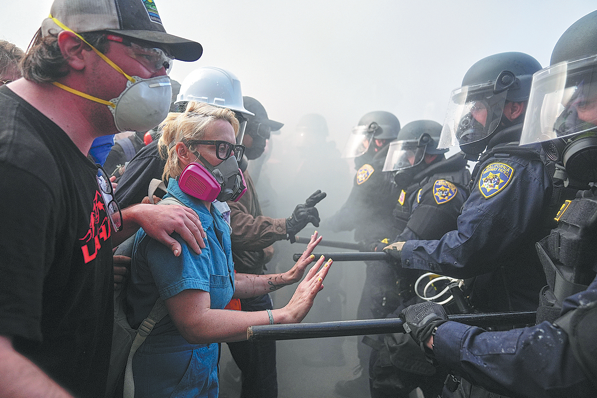MTR bears brunt of violence in HK
China Daily Global | Updated: 2019-10-21 09:49

Weekend protests result in frequent overtime for employees of subway operator, which is likely to see revenue fall
Hong Kong's pride, the Mass Transit Railway system, is struggling through the worst year in its four-decade history. The system that has earned worldwide plaudits for its efficiency finds itself at the center of the city's current woes. Today, the MTR is grasping for strategies to weather the storm. It has been called the biggest challenge faced by the corporation.
"MTR Corp is struggling to strike a balance between safety and service delivery," said a senior MTR manager who did not want to be named.
There was no respite for the MTR this Sunday too.
Vandalism by black-clad protesters forced the closure of at least 17 stations by the MTR on three lines by 6 pm. Rioters, who broke into shops with known links to the Chinese mainland in the central Kowloon area, set fires at some stations, vandalized a district councilor's office and broke traffic lights, paralyzing traffic.
Despite some subway stations having been closed, radicals tore down the MTR signs and smashed the glass facade at the entrance. Protesters set fire to the entrance of the Mong Kok station by tossing gasoline bombs into it.
Over the past two months, the subway system has been attacked by violent mobs almost every week. The network had managed to complete repairs and clean up in time for the resumption of services at 6 am.

The senior manager recalled that at 4 am on Oct 5, when rioters ended their rampage hours after the city's anti-mask law came into effect, staff members at different stations were called out to inspect the stations and make arrangements for repairs. The city continued to reel amid the citywide chaos that saw hundreds of shops and banks vandalized, in addition to many subway stations.
The first three stations the manager inspected had sustained fire damage, smashed turnstiles and ticket vending machines, and surfaces defaced by graffiti. The damage was unprecedented and the manager had to report that repairs could not be completed early in the morning.
On Oct 5, however, the MTR was down for the count. All lines and stations had to be closed all day - more than 80 of 93 stations had been damaged.
It wasn't until Oct 11 that the full system was back in operation. Tseung Kwan O Station, the last to finish repairs, provided only limited services.
By the time the station reopened, only four of 26 turnstiles, one of five ticket machines, and four of seven escalators were operational, according to the MTR's chief of operations, Sammy Wong Kwan-wai.
Some glass doors on platforms that had been smashed were replaced with aluminum boards. The rail operator also cleared debris which had been thrown onto the rail tracks amid the rampage.
On Aug 5, the MTR train services were paralyzed when anti-government protesters launched a "noncooperation movement". Masked protesters pressed emergency buttons on the carriages, and blocked train doors from closing during rush hour. Eight lines had to suspend services.
Disputes erupted at some stations. Protesters smashed turnstiles and ticketing machines, wrecked surveillance cameras and firefighting equipment at the stations. The MTR employees were harassed and intimidated.
The city felt another shock on Sept 8, when protesters started a fire at an exit of Central Station on Hong Kong Island. Before long, arson became a standard tactic among rioting protesters. When stations were closed, protesters smashed windows at the exits and tossed gasoline bombs inside.
Once a fixture at a subway station or a train is damaged, staff members have to inspect all facilities, looking out for damage to avoid mishaps.
The uncertainties arising from attacks result in "tons of work", the manager said.
Due to constant damage to railway facilities, a dwindling number of spare parts for repairs made the problem increasingly acute, according to Adi Lau Tin-shing, operations director of MTR.
Various facilities, including 1,200 turnstiles, 800 ticketing machines, 900 closed circuit television cameras, and 50 escalators, have been damaged, causing costs of up to HK$40 million ($5.1 million).
Some spare parts have been exhausted and replacement parts have had to be ordered overseas. They will not arrive in Hong Kong until November, said Lau.
Before that, the company mobilized the employees to deal with the crisis. For example, staff members were added to help recharge rail cards or sell tickets before the ticketing machines were fixed.
At damaged turnstiles, MTR workers hold sensors for passengers to tap their transport cards, while computer screens show the balance of the cards.
The temporary replacement was a brainchild of the engineering team, said the manager.
For the past two months, working overtime and sometimes overnight has been the norm for MTR employees. Most are accustomed to working in shifts during the 18 hours of operations. Now, once a subway station becomes damaged during protests, which frequently occurred during weekends, some employees remain on duty to clean up and repair damages, before the service begins again at 6 am.
These efforts have ensured that most MTR services are restored in time for about 5 million passengers who use the network each day.
Some services had to make way. For example, the MTR employees who specialize in providing services to the disabled, were temporarily seconded to other jobs.
Some barrier-free facilities that have been damaged still await repairs.
Protesters smashed the only lift at Yau Ma Tei Station. It is located adjacent to Kwong Wah Hospital, a major public hospital in southern Kowloon. As a result, elderly patients of the hospital, as well as the disabled and passengers with heavy luggage or prams, are forced to take the stairs.
Every single part has its purpose in this vast and complex system, the manager said. "Each missing element could create a trail of problems."
The pressure of working overtime seems a small inconvenience when considered alongside the difficulties of enforcing regulations while violent protesters are intent on creating disruption, the manager said.
It never was a "mission impossible" for the MTR staff members to stop people from stealing rides, until masses of protesters did so recently. Mobs were seen jumping over turnstiles without paying, to avoid being identified if they use their transportation cards.
The MTR employees complained that when they tried to apprehend fare jumpers, a crowd would form and hurl abuse at staff members for "obstructing the demonstrations".
Nothing like this has ever happened before, the manager said. The person recalled transportation in the city becoming obstructed, in 2005, when South Korean farmers sparked riots, surrounding the Sixth Ministerial Conference of the World Trade Organization. Back then, the rioters were condemned by the public in general, and staff members had little difficulty maintaining order.
Stealing rides poses a serious concern for the city's public transportation system, the staff member said. The individual noted that the MTR's high efficiency is based on mutual trust and a high degree of self-discipline among Hong Kong people.
A sharp drop in MTR's revenue is likely to result from decreased passenger traffic during recent months. MTR reported a decline of 7.5 percent year-on-year in passenger traffic in August.
The Airport Express that links Hong Kong International Airport and the city's principal urban areas saw a drop of 10 percent in passenger traffic, presumably due to direct disruptions of the airport by protesters on Aug 12 and 13.
The Hong Kong West Kowloon high-speed rail station, constructed by MTR and commissioned late last year, carried 1.14 million passengers in August, down nearly 30 percent from July.
Ridership has been affected by a 40 percent drop in tourist arrivals in the city over the past month alone. In the meantime, the people of Hong Kong are cutting back on shopping and leisure dining, because of frequent disruptions caused by protests, including violent clashes across the city.
China Daily
























